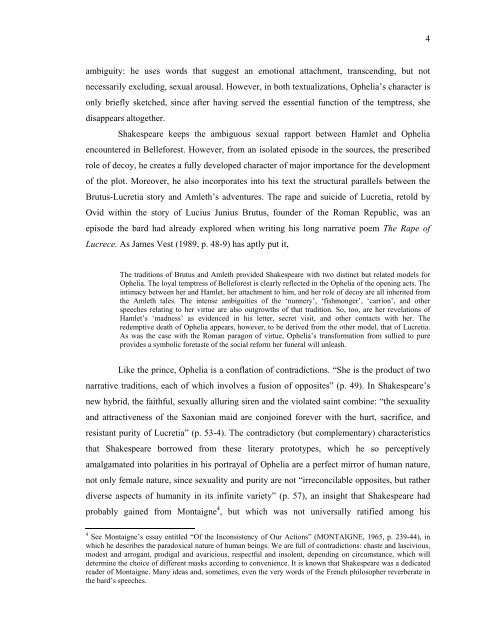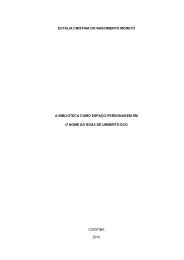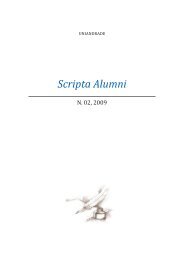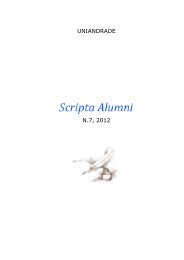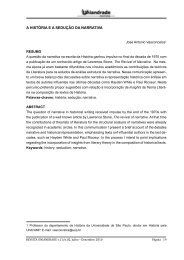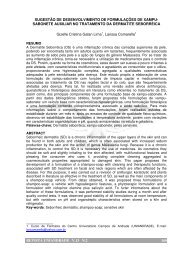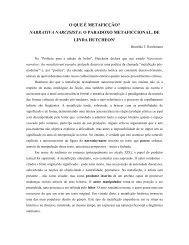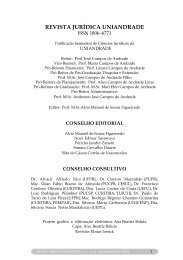REREADING SHAKESPEARE'S OPHELIA: MARCELO ... - Uniandrade
REREADING SHAKESPEARE'S OPHELIA: MARCELO ... - Uniandrade
REREADING SHAKESPEARE'S OPHELIA: MARCELO ... - Uniandrade
You also want an ePaper? Increase the reach of your titles
YUMPU automatically turns print PDFs into web optimized ePapers that Google loves.
ambiguity: he uses words that suggest an emotional attachment, transcending, but not<br />
necessarily excluding, sexual arousal. However, in both textualizations, Ophelia’s character is<br />
only briefly sketched, since after having served the essential function of the temptress, she<br />
disappears altogether.<br />
Shakespeare keeps the ambiguous sexual rapport between Hamlet and Ophelia<br />
encountered in Belleforest. However, from an isolated episode in the sources, the prescribed<br />
role of decoy, he creates a fully developed character of major importance for the development<br />
of the plot. Moreover, he also incorporates into his text the structural parallels between the<br />
Brutus-Lucretia story and Amleth’s adventures. The rape and suicide of Lucretia, retold by<br />
Ovid within the story of Lucius Junius Brutus, founder of the Roman Republic, was an<br />
episode the bard had already explored when writing his long narrative poem The Rape of<br />
Lucrece. As James Vest (1989, p. 48-9) has aptly put it,<br />
The traditions of Brutus and Amleth provided Shakespeare with two distinct but related models for<br />
Ophelia. The loyal temptress of Belleforest is clearly reflected in the Ophelia of the opening acts. The<br />
intimacy between her and Hamlet, her attachment to him, and her role of decoy are all inherited from<br />
the Amleth tales. The intense ambiguities of the ‘nunnery’, ‘fishmonger’, ‘carrion’, and other<br />
speeches relating to her virtue are also outgrowths of that tradition. So, too, are her revelations of<br />
Hamlet’s ‘madness’ as evidenced in his letter, secret visit, and other contacts with her. The<br />
redemptive death of Ophelia appears, however, to be derived from the other model, that of Lucretia.<br />
As was the case with the Roman paragon of virtue, Ophelia’s transformation from sullied to pure<br />
provides a symbolic foretaste of the social reform her funeral will unleash.<br />
Like the prince, Ophelia is a conflation of contradictions. “She is the product of two<br />
narrative traditions, each of which involves a fusion of opposites” (p. 49). In Shakespeare’s<br />
new hybrid, the faithful, sexually alluring siren and the violated saint combine: “the sexuality<br />
and attractiveness of the Saxonian maid are conjoined forever with the hurt, sacrifice, and<br />
resistant purity of Lucretia” (p. 53-4). The contradictory (but complementary) characteristics<br />
that Shakespeare borrowed from these literary prototypes, which he so perceptively<br />
amalgamated into polarities in his portrayal of Ophelia are a perfect mirror of human nature,<br />
not only female nature, since sexuality and purity are not “irreconcilable opposites, but rather<br />
diverse aspects of humanity in its infinite variety” (p. 57), an insight that Shakespeare had<br />
probably gained from Montaigne 4 , but which was not universally ratified among his<br />
4 See Montaigne’s essay entitled “Of the Inconsistency of Our Actions” (MONTAIGNE, 1965, p. 239-44), in<br />
which he describes the paradoxical nature of human beings. We are full of contradictions: chaste and lascivious,<br />
modest and arrogant, prodigal and avaricious, respectful and insolent, depending on circumstance, which will<br />
determine the choice of different masks according to convenience. It is known that Shakespeare was a dedicated<br />
reader of Montaigne. Many ideas and, sometimes, even the very words of the French philosopher reverberate in<br />
the bard’s speeches.<br />
4


